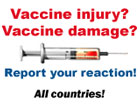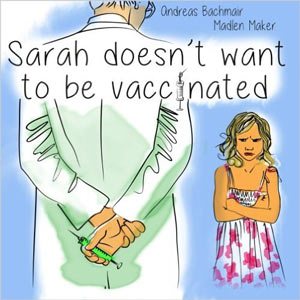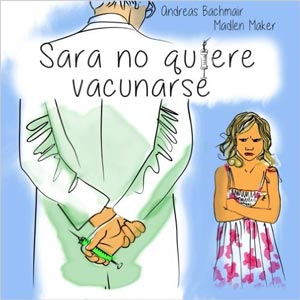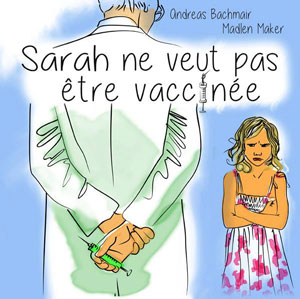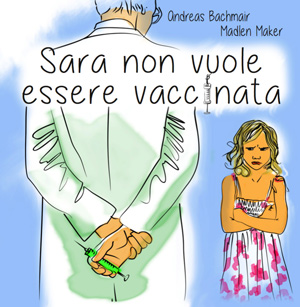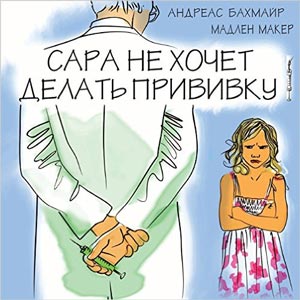Tick-borne encephalitis disease, TBE disease
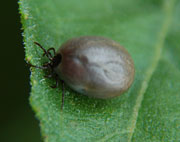
Pathogen
The TBE virus is the pathogen whose host is ticks. Only very few ticks contain this pathogen. (They transmit Borreliosis much more frequently). In tick areas like Baden Württemberg, Germany, the frequency rises to 1:1000, otherwise it is at l1:20000. The virus can only survive in ticks which live less than 1000 m above sea level.
Course of the disease
Nothing happens in 60-70% of people who were bitten by an infected tick. 20-30 % has flu-like symptoms and the nervous system is only affected in 5-10% of people. The incubation period is about 7-10 days, sometimes it is longer. First there is fever, headaches and joint pain, after a fever-free period the temperature goes up again and 4-6 days accompanied by a headache, later there are meningeal symptoms.
Approx. 5 percent of people who have been infected contract a benign case of meningitis, an additional 5% contract meningoencephalitis, in other words an inflammation that also affects the brain. Severe courses of the disease and lasting damage and even mortalities can be expected only if there are complications. Initial symptoms include fatigue and loss of consciousness, cramps and/or paralysis.
Children
According to the Paul-Ehrlich Institute "the course TBE takes in children is much less severe than it is with adults and generally heals without any lasting damage. Irreparable neurological damages are rare."
The Robert-Koch Institute also indicates that TBE almost always has a benign course in children and adolescents. „Severe courses are almost exclusively observed in adults“ (RKI (Robert Koch Institut): Frühsommer-Meningoenzephalitis (TBE). RKI-RatgeberInfektionskrankheiten–MerkblätterfürÄrzte.Stand:28.04.2006http://www.rki.de/nn_196658/DE/Content/Infekt/EpidBull/Merkblaetter/Ratgeber__Mbl__TBE.html).
In August 2004 the German Ärzteblatt reported the following: „The prognosis for TBE in children can be judged as positive considering our own findings and data that have been published in the last 30 years. [...] In children younger than 6 years of age defects only healed after TBE when the children had had passive immunization after a tick bite and/or had received a high dose treatment of dexamethason (cortisone) in addition to antibiotics after the initial suspicion of a bacterial meningitis“ (Kaiser R: Frühsommer-Meningoenzephalitis: Prognose für Kinder und Jugendliche günstiger als für Erwachsene. Dtsch Ärztebl 2004, 101:A-2260).
There was not a single severe case with lasting damage or death among 371 Slovak children aged 0-15 years who had TBE (Lesnicar, G., Poljak, M., Seme, K., Lesnicar, J.: Pediatric tick-borne Encephalitis in 371 cases from an endemic region in Slovenia, 1959 to 2000. Pediatr Infect Dis J 2003, 22(7):612-7).
In the German literature there is only one report of TBE damages in a child, i.e. a 12-year-old boy (AT 2001/4). There are individual reports of paralysis, epilepsia or behavioral disorders after TBE in children in Austria and Slovenia. (DAKJ (Deutsche Akademie für Kinder und Jugendmedizin): Prävention der TBE. Stellungnahme der Kommission für Infektionskrankheiten und Impffragen der DAKJ. Kinderärztl. Prax 2004, 4:259-261).
Therapy
Every tick should be removed immediately. Don’t use oil or any other materials which kill ticks. If you do that, the stomach contents of the tick will go into the skin and can promote infection. Instead, the tick should be carefully pulled out with tick pliers. The therapy is according to symptoms. In children the disease is generally benign and the risk of contracting TBE is significantly lower in children than in adults. (http://www.BAG.admin.ch/infreporting/)
Complications
In 1 to 2% meningeal encephalitis is lethal, in 3 to 11 % there are lasting damages such as lack of concentration, fatigue or chronic headaches. Rarely does the paralysis persist, mainly in older people (EB (Epidemiologisches Bulletin) 1999: Ratgeber Infektionskrankheiten – Frühsommer-Meningoenzephalitis).
The diseases heals completely, frequently even after severe cases (Arzneitelegramm 1996,6). Mathematically, the risk of permanent damage as a result of TBE after a tick bite in Southern Germany is between 1:15.000 and 1:150.000, the risk of a fatal case of TBE is between 1:100.000 and 1:1 million. Every year one death on average is reported (GBE (Gesundheitsberichterstattung des Bundes): Sterbefälle 1980 – 1997. http://www.gbe-bund.de/oowa921-install/servlet/oowa/aw92/dboowasys921.xwdevkit/xwd_init?gbe.isgbetol/xs_start_neu/374381498/52530306).
Disturbances of the function of the brain, including apraxia and damages to the sense organ only occur in 1 out of 80000 people with a severe case (Roggendorf, M., Girgsdies, O. E.Rosenkranz, G Epidemiologie und Prophylaxe der Frühsommermeningitis; DIe gelben Hefte 1994, 2: 74-80).
Immunity
Immunity is life long after the disease has been undergone.
TBE
Ticks that transmit TBE only happen in certain areas. And only every 100th to 1000th tick is affected in these areas. TBE does not occur above 1000 m sea level, as the average temperature is too low. This may change in the future as a result of rising temperatures
The main area of prevalence of TBE in Europe is Russia, the Baltic countries, South East Sweden, Hungary, Poland, Slovenia, the Czech Republic and Eastern Austria (prevalence map:: www.meb.uni-bonn.de/giftzentrale/TBE2002/eu.html ).
There is no TBE risk on the Iberian Peninsula, in Great Britain, the Benelux countries and Denmark. There are only individual cases in France, Italy and Greece.
There are endemic infection areas in Switzerland and in Liechtenstein. Two main endemic areas have been observed, one in central Switzerland and the other in the upper Rhine valley. Aside from the known endemic infection areas in the regions around Schaffhausen, Thun and Biel-Ins, other areas have also been discovered in the past 20 years. They are along the banks of Lake Zurich and in the region around Chur and Liechtenstein. www.rki.de/cln_048/nn_196658/DE/Content/Infekt/EpidBull/Archiv/2003/07__03,templateId=raw,property=publicationFile.pdf/07_03.pdf
The main areas that are affected in Germany are Bavaria and Baden-Württemberg.
Bavaria: the southern part of the Bavarian Forest, Lower Bavaria along the Danube after Deggendorf (particularly the area around Passau) as well as along the rivers of Paar, Isar (after Landshut), Rott, Inn, Vils and Altmühl. The only high-risk area in Bavaria is the area around Passau. There are individual cases in middle and upper Frankonia.
Baden-Württemberg: all of the Black Forest (area around Pforzheim, Offenburg, Freiburg, Villingen, Tübingen, Sindelfingen), in areas along the rivers Enz, Nagold and Neckar as well as along the upper part of the Rhine and above Kehl stretching over to the Western part of Lake Constance (Constance, Singen, Stockach). High risk areas are the areas around Calw, Ortenau-Kreis, Emmendingen, Breisgau-Hochschwarzwald, Rottweil, Waldshut, Constance and Freiburg. One area where TBE is very prevalent is Dreisamtal near Freiburg where there are 15 cases of TBE every year among the 21000 people who live there. Individual cases of TBE were observed in the Odenwald in Hessia, in Rheinland Pfalz and along the river Saale in Thuringia.
So-called TBE-prevalence maps are an indication for risk areas. However, between 2006 and 2007 there were significant redefinitions which led to a much higher number of risk areas. Risk areas are subject to a new definition (EB (Epidemiologisches Bulletin): Statement of RKI on TBE-vaccinations. EB 2007, 17:150-151) Cities and rural areas which have more than one infected person per 100000 inhabitants within five years (risk > 1:500.000). This pertained to 80 areas in Germany in 2006. According to information provided by the Robert Koch Institut the upper limit is very low ((EB (Epidemiologisches Bulletin): Stellungnahme des RKI zu TBE-Impfungen. EB 2007, 17:150-151))
Since 2007 there is no differentiation between risk and high risk areas which makes it more difficult to decide whether to have an TBE vaccination.
Since 2007 risk areas include areas that didn’t use to be risk areas but which border areas whose added risk is more than the above-mentioned 1:100.000. This is why there are 33 more areas across Germany, including Mannheim, Ansbach and Hohenlohekreis, areas in which there has never been one case of TBE.
This new definition is confusing and not very helpful if one considers that the increase in TBE infections is almost exclusively based on tick bites in areas that were already recognized as risk areas.
The Arznei-telegramm in its 38th year, 13. Juli 2007 7/2007 states that the probability of contracting a full-fledged case of TBE from a tick bite in a risk area is „very low“ and depends on the prevalence of these ticks which must 1 : 10.000 (tick prevalence approx. 0,1%) and 1 : 300 (tick prevalence rate ca. 3.5%)"


